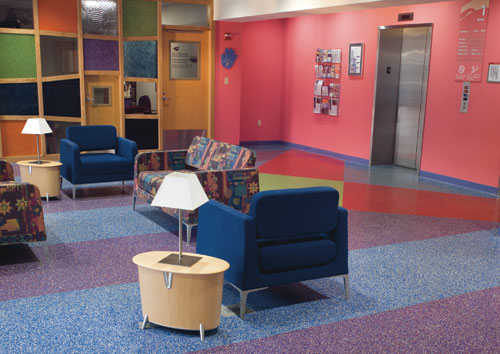Sustainable Rubber Flooring for Healthcare and Education
Fall Protection
Even with high slip resistance, falls inevitably occur. In these cases, the quality and composition of the flooring can prevent serious injury or worse. In some applications, such as athletic surfaces or schools full of running kids, falls are just a part of doing business. Recycled rubber flooring can prevent injury and stress on joints of any age.
The key measurements for flooring that provide fall protection are also closely related to comfort. They include:
Compression: (F36) The flexibility of surfacing to cave under the repeated impact of weight (such as walking). A mid-range percentage is desirable for cushioned support.
 |
The performance of the floor in healthcare facilities can contribute significantly to healing by providing comfort, safety, healthy indoor air quality, and a quiet and restful atmosphere. This floor in the Peyton Manning Children's Hospital at St. Vincent in Indianapolis adds the colorful, artistic appeal that has been shown to lower stress and increase well-being in patients, their families and visitors, and hard-working staff. |
Resistance to Head Injury: (ASTM 1292) This testing measures the ability of the flooring surface to cushion and absorb the impact of an object being dropped on the floor, or a person falling and hitting their head on the floor. This is typically denoted as “pass/fail,” based on certain criteria that are calculated from the test, such as Maximum Deceleration (i.e. “g-max”) and HIC or Head Injury Criterion.
Sound Performance
The importance of quiet in healthcare facilities is a subject of intense research but it is also clear to anyone who has spent a night in a typical hospital. A 2005 study at Johns Hopkins Hospital found that hospital noise has been rising since the 1960s to levels well beyond those recommended by the World Health Organization. The Center for Health Design study mentioned above cited many other examples clearly showing the negative effect of noise on patients and caregivers, in terms of elevated stress, difficulty in staff and patient communications, poor sleep, and medical error due to noise distractions.
In education, the simple inability to hear properly has been linked to a host of problems including poor grades, behavior issues, and teacher stress. For example, a multi-year study undertaken by the Orange County Public School District (OCPS) in Orlando, Florida, compared teacher retention and student test scores in classrooms which had acoustical improvements and those without. Students in sound-enhanced classrooms scored 10 percent higher on average on Florida achievement tests, and teacher absenteeism in the classrooms with better acoustics was 25 percent less. OCPS now requires sound enhancement systems in every new and renovated school.
Acoustic performance is not a luxury, but an important determinant of outcomes, and flooring plays a key role.
For sound transmission between spaces, two basic ways of measuring acoustical performance are Sound Transmission Class (STC, ASTM E90, E336) ratings and Impact Insulation Class (IIC, ASTM E492, E1007, E2179) ratings. STC measures a partition or floor-ceiling assembly's ability to block sound borne through the air, such as voices or music. IIC measures an assembly's ability to isolate impact noise, like a footstep or furniture moving overhead in a multistory building. In general, a higher rating indicates better performance. STC and IIC ratings typically range from 25, which is considered poor, to 50, acceptable, to 60 and above, for good performance.
Tests measure a floor-ceiling assembly, and to interpret the ratings correctly it is very important to know test factors. This includes finishes on the floor, the thickness of the floor, the construction and material of the subfloor and ceiling, and many other details which may affect the ratings. A Delta IIC test (ASTM E2179), usually written as ΔIIC, is used as an indication of how a floor covering performs over a standard 6-inch concrete slab, although this, too, will depend on the composition of the flooring assembly.
Recycled rubber flooring offers extremely high sound reduction along with its other attributes of sustainability and durability. Underlayments are also easy to install with virtually all other floor finishes, in single or multistory buildings. Recycled rubber is available in various thicknesses, but in general it can meet strict building code requirements while adding minimal floor height. (See “Bard's Crossing” case study.)
As Pretty Does
A recent survey of healthcare executives asking about trends affecting the industry in the coming year found that providers are strongly focused on fostering a culture that increases employee engagement and patient satisfaction. As hospitals and other establishments compete with each other for patients, patient satisfaction will be measured and promoted more intensively. Healthy, comfortable, colorful environments become an essential part of the business plan. For example, a recent study at a pediatric hospital indicated higher parent satisfaction with the aesthetics of a facility was directly associated with their satisfaction concerning the healthcare services.









